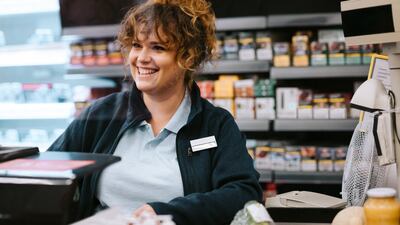Omnichannel is everywhere. Literally. And there’s a reason for that. A typical shopper journey no longer means just visiting a shop or two and maybe chatting to a salesperson before making a decision. It now uses a mix of online and offline channels. For example, shoppers can research online, compare items with one retailer or across many, then physically go to the shop and purchase in-store. Alternatively, they can do their research in-store, speak to a sales agent in person, go home to think about it and buy online at a time that suits them, whether that’s midnight on a Monday or 5pm on a Friday.

Online shopping may have grown significantly during lockdowns, but lots of people are returning to stores at the earliest opportunity.
[ The Irish Times ePaperOpens in new window ]
This then is omnichannel. Omnichannel, in retailing at least, means having a multichannel approach to sales that provides a frictionless, seamless shopper journey both online – on desktop and mobile – and in-store. It focuses on the entire shopper experience, no matter where the customer is accessing the business from.
Why do Irish retailers need omnichannel?
Thanks to improvements in and accessibility of technology such as smartphones, shopper behaviour has significantly changed over the last few years, with shoppers often researching online – sometimes on their phones while in-store – before purchasing, either then or later online.
"Smartphones have entirely transformed the behaviour of almost all consumers. Searching by mobile, buying online, purchasing or returning in physical stores – consumers are increasingly demanding a uniform experience across multiple sales channels. Omnichannel retail is the customer-centric approach to deliver a seamless experience, regardless of channel or device," says Michael Bosshammer, head of retail for Elavon.

In addition to shopper behaviour changing, shopper expectations have also increased, and retailers need to rise to that demand. Bosshammer continues, “Omnichannel gives retailers the leeway they need to compete against their online-only rivals. Omnichannel trends show that customers are still interested in physical retail – but with digital touchpoints that enrich the shopping experience. Retailers need to embrace the lifestyle of their customers and offer them convenience and fulfilment they demand.”
Pandemic purchases
While a recent survey by Foresight Factory found that 60 per cent of people still prefer shopping in person to shopping online, the pandemic has made something very clear – particularly to smaller, local retailers. Only having a brick-and-mortar presence makes them vulnerable. When the pandemic hit, many small retailers had to scramble to provide an online presence, or risk closing altogether. Luckily those who mastered their online offering found that when business returned to normal, they had multiple channels for shoppers to use. And shoppers – many of whom, particularly in older demographics, were similarly pushed online by the pandemic – have embraced online shopping in a way that they never would have imagined. Win-win, right? Maybe, maybe not.
Successful omnichannel operations
"Omnichannel is a natural part of our evolution," says Paul Prior, head of digital at Three Ireland. "Our job is simple: respond to the demands of the market and our customers in a way that is comfortable and familiar. Omnichannel is a basic expectation."

Operating an omnichannel model has worked well for Three Ireland with customer service, supply chain and stock management all positively impacted. “When you have multiple sales channels, you need to know where your stock is and through what channel it will be fulfilled. A byproduct of omnichannel is it can open you up to more stock-keeping units (SKUs). More SKUs means more efficiency required in the supply chain,” says Prior.
While most larger retailers already had an online offering in addition to their brick-and-mortar stores and could pivot their operations fully online as needed, smaller retailers needed to scurry to catch up.
Providing omnichannel options and successfully optimising omnichannel are two very different beasts as retailers new to the premise soon found out. From implementing a proper ecommerce offering to managing SKUs, product descriptions, online payments, inventory, supply chain and logistics, there are many factors to omnichannel that may not seem immediately apparent.
Some of the biggest challenges that smaller retailers face when operating omnichannel offerings were – and may continue – to be delivery and related costs. In the beginning, these retailers may have struggled to find final mile carriers quickly, had to use couriers or opted to do delivery themselves. With customer expectations around free or next-day delivery being high, retailers often had to absorb these costs or risk losing the sale. Managing these costs – whether setting thresholds for free delivery, providing cheaper slower delivery options or paid express delivery – will be key for smaller retailers to navigate moving forward.
Pay as you go
From a payments perspective, omnichannel is the ability to take payments anywhere, according to Robert Doherty, director of product, AIB Merchant Services. "We would see omnichannel as the need to take payments in any environment. Shopping online should be as convenient as shopping in-store."
Orla Bowers, senior product manager, AIB Merchant Services, believes implementing online payment processes was often the easiest part of the omnichannel journey for most retailers. "Traditionally omnichannel – buying online, returning in-store for example – would have been reserved for larger retailers. It's not as simple as it sounds to have that infrastructure set up. However, with payments, there are so many more ways to pay that retailers could implement relatively easily, such as payment links by SMS."
The future of omnichannel
A survey by the Harvard Business Review showed that 73 per cent of all customers use multiple channels throughout their purchases, indicating omnichannel is here to stay. As shoppers become more comfortable shopping both on and offline, the expectation of having multiple channels to research, buy, contact customer services and return products when and where they want will increase. Innovations in technology such as virtual dressingrooms or replicating the in-store experience virtually already exist and are going to become much more ubiquitous, meaning retailers will need to stay on top of trends to stay ahead of the game.












